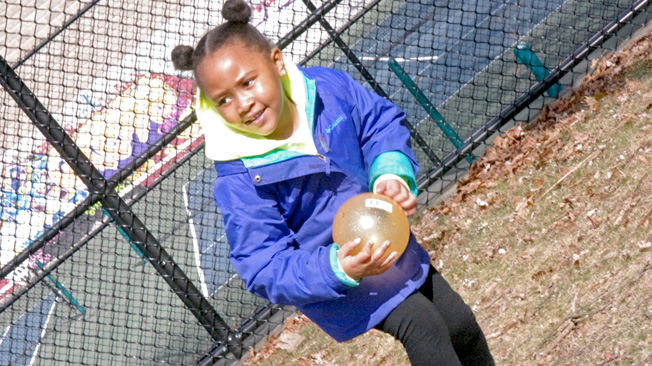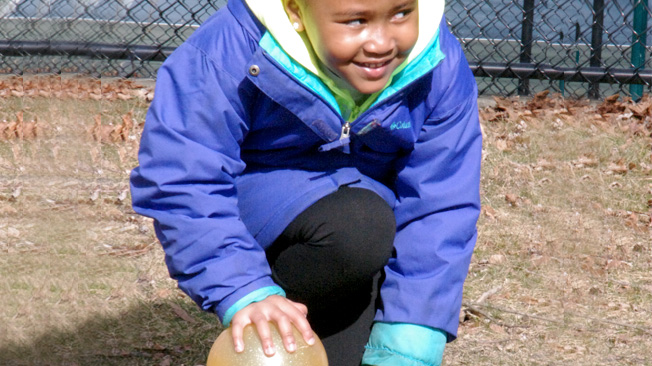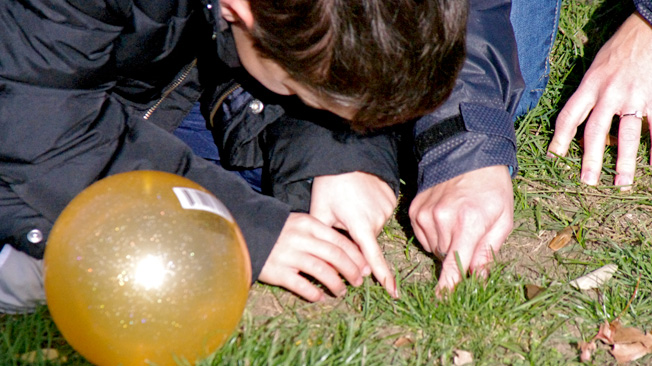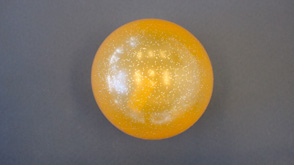Fly It and Spy It

What Is This Activity?
Is your neighborhood teeming with wildlife? Surprisingly, yes—but you have to look very closely to see it. Visit a park with your child to discover what's living under your feet and above your head. Then imagine seeing the world from the viewpoint of an ant!
Introduction

Big Science Ideas
- Animals live in places wherethey can find food, water, shelter, and space to survive.
Go Outside 45 minutes
- In a park or playground, play catch with the ball or toss the flying disk for a few minutes. Then, with drama, toss the ball away! Have your child run to where it lands. Wonder aloud: What lives above and around that ball? What lives underneath it?
- Look up at the sky together. Ask: re any birds or bugs flying above or in a tree? What are they doing? (Hunting for prey, eating seeds,moving to a new place, resting, nesting, etc.)
- Pick up the ball and look at the patch of ground together. Turn over a rock or stick to look for animals like worms, ants, or roly-poly bugs. How many types of plants and animals can you find? If you see very few or no life-forms, talk about why. Ask: Were they scared away or are they hiding? Why do you think there are no plants under the rock? How can we get some animals to come to this spot? (Optional: Set out a fruit slice or two and moisten the area, skip to step 5, and then revisit this ground in five to 10 minutes to see what is there.)
- Imagine that you and your child have both shrunk to the size of ants. Wonder aloud: What does the grass look like to us? Where do we find food? Where do we hide if a bird swoops down to eat us? Where is a good place to dig an anthill? What's our biggest danger? You might share your own pretend observations to make it more fun: Wow, that stalk of grass looks like a tree! There are lot of us ants down here.
- Ask your child what your family needs to survive (food, water, shelter, and space to survive). Tell your child that even the tiniest critters need the same things as "gigantic" people to survive.
- Throw the ball to a new location and repeat the activity. This time, have your child pretend to be a different animal—a rabbit or bird, for example.
- For older or more mature children: Challenge them to think about places or things that are likely to attract lots of tiny animals and then explore those places to see if their predictions are right. For example, sun or shade. Grass, bare soil, or other ground. Ground that's wet, moist, or dry. Near trees or away from them. Near where people gather or not. What about sources of food (garbage cans, for example)? And water (ponds, fountains, puddles)?
- On your way home, find a tree trunk, a fence, a large rock, or a wall. Can your child find anything living here? Ask: How is this place different from the other place you explored? If you spy an animal, ask: What is it doing here? If you don't find an animal, ask: Why are there no animals here? What animals might we find here at night? What might we find in a different season, when it's warmer, cooler, or wetter?
Explore Some More
Watch: Wild, Wild Life
Watch this short video in which Cooper and Brad are accidentally shrunk to the size of an ant. The grass looks like a forest filled with giant beetles, earthworms, and spiders! Encourage your child to imagine himself or herself as an ant and write an adventure story or draw a picture from the ant's point of view. What can your "ant" do to survive?
Plum's Creaturizer App
If you have a smartphone, download Plum's Creaturizer app from the website. You can build imaginary creatures and then take photos of the creatures outdoors, photobombing them into the scene! Use the app to help your child photograph the creature finding food, water, and shelter in the places you visit.
Outdoor Family Fun with Plum App
This app gets families outdoors exploring the world. Every day, the app offers five outdoor missions to get everyone thinking and talking about nature and the science that's all around us.


